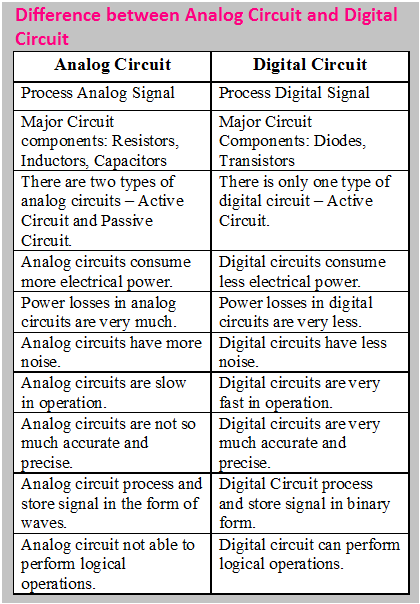Analog Circuit VS Digital Circuit Examples, Use, Advantages
Analog Circuit Examples
- Audio Amplifiers
- RF Filters
- Voltage Dividers
- Radio Communication Circuit
- AC Power Circuit
- Audio Equilizer Circuit
- Noise Processing Circuit
- Operational Amplifiers
- Rectifier Circuit
- Telephone Circuitry
- Analog Computer Circuits
Digital Circuit Examples
- Computer Keyboard Circuit
- Digital Memory Circuit
- Digital Encoder
- Decoder
- Timer
- Counter
- Microprocessor Internal Circut
- CPU Circuit
- Remote Control Circuit
- Flip Flop
- Registers
Difference between Analog Circuit VS Digital Circuit
| Analog Circuit | Digital Circuit |
| Process Analog Signal | Process Digital Signal |
| Major Circuit components: Resistors, Inductors, Capacitors | Major Circuit Components: Diodes, Transistors |
| There are two types of analog circuits – Active Circuits and Passive Circuits. | There is only one type of digital circuit – Active Circuit. |
| Analog circuits consume more electrical power. | Digital circuits consume less electrical power. |
| Power losses in analog circuits are very much. | Power losses in digital circuits are very low. |
| Analog circuits have more noise. | Digital circuits have less noise. |
| Analog circuits are slow in operation. | Digital circuits are very fast in operation. |
| Analog circuits are not so much accurate and precise. | Digital circuits are very much accurate and precise. |
| Analog circuits process and store signals in the form of waves. | Digital Circuit processes and store signal in binary form. |
| Analog circuits are not able to perform logical operations. | Digital circuits can perform logical operations. |
- Fast Operation
- Less Noise
- Less Power Loss
- Easy Design
- Compact Size
- High Efficiency

